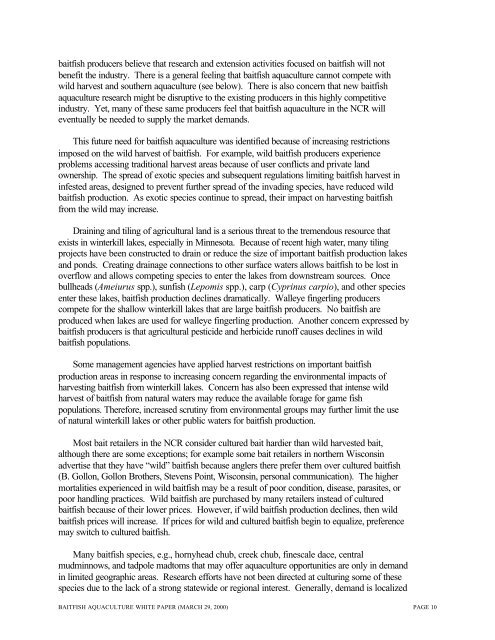a white paper on the status and needs of baitfish ... - NCRAC
a white paper on the status and needs of baitfish ... - NCRAC
a white paper on the status and needs of baitfish ... - NCRAC
Create successful ePaper yourself
Turn your PDF publications into a flip-book with our unique Google optimized e-Paper software.
aitfish producers believe that research <strong>and</strong> extensi<strong>on</strong> activities focused <strong>on</strong> <strong>baitfish</strong> will not<br />
benefit <strong>the</strong> industry. There is a general feeling that <strong>baitfish</strong> aquaculture cannot compete with<br />
wild harvest <strong>and</strong> sou<strong>the</strong>rn aquaculture (see below). There is also c<strong>on</strong>cern that new <strong>baitfish</strong><br />
aquaculture research might be disruptive to <strong>the</strong> existing producers in this highly competitive<br />
industry. Yet, many <strong>of</strong> <strong>the</strong>se same producers feel that <strong>baitfish</strong> aquaculture in <strong>the</strong> NCR will<br />
eventually be needed to supply <strong>the</strong> market dem<strong>and</strong>s.<br />
This future need for <strong>baitfish</strong> aquaculture was identified because <strong>of</strong> increasing restricti<strong>on</strong>s<br />
imposed <strong>on</strong> <strong>the</strong> wild harvest <strong>of</strong> <strong>baitfish</strong>. For example, wild <strong>baitfish</strong> producers experience<br />
problems accessing traditi<strong>on</strong>al harvest areas because <strong>of</strong> user c<strong>on</strong>flicts <strong>and</strong> private l<strong>and</strong><br />
ownership. The spread <strong>of</strong> exotic species <strong>and</strong> subsequent regulati<strong>on</strong>s limiting <strong>baitfish</strong> harvest in<br />
infested areas, designed to prevent fur<strong>the</strong>r spread <strong>of</strong> <strong>the</strong> invading species, have reduced wild<br />
<strong>baitfish</strong> producti<strong>on</strong>. As exotic species c<strong>on</strong>tinue to spread, <strong>the</strong>ir impact <strong>on</strong> harvesting <strong>baitfish</strong><br />
from <strong>the</strong> wild may increase.<br />
Draining <strong>and</strong> tiling <strong>of</strong> agricultural l<strong>and</strong> is a serious threat to <strong>the</strong> tremendous resource that<br />
exists in winterkill lakes, especially in Minnesota. Because <strong>of</strong> recent high water, many tiling<br />
projects have been c<strong>on</strong>structed to drain or reduce <strong>the</strong> size <strong>of</strong> important <strong>baitfish</strong> producti<strong>on</strong> lakes<br />
<strong>and</strong> p<strong>on</strong>ds. Creating drainage c<strong>on</strong>necti<strong>on</strong>s to o<strong>the</strong>r surface waters allows <strong>baitfish</strong> to be lost in<br />
overflow <strong>and</strong> allows competing species to enter <strong>the</strong> lakes from downstream sources. Once<br />
bullheads (Ameiurus spp.), sunfish (Lepomis spp.), carp (Cyprinus carpio), <strong>and</strong> o<strong>the</strong>r species<br />
enter <strong>the</strong>se lakes, <strong>baitfish</strong> producti<strong>on</strong> declines dramatically. Walleye fingerling producers<br />
compete for <strong>the</strong> shallow winterkill lakes that are large <strong>baitfish</strong> producers. No <strong>baitfish</strong> are<br />
produced when lakes are used for walleye fingerling producti<strong>on</strong>. Ano<strong>the</strong>r c<strong>on</strong>cern expressed by<br />
<strong>baitfish</strong> producers is that agricultural pesticide <strong>and</strong> herbicide run<strong>of</strong>f causes declines in wild<br />
<strong>baitfish</strong> populati<strong>on</strong>s.<br />
Some management agencies have applied harvest restricti<strong>on</strong>s <strong>on</strong> important <strong>baitfish</strong><br />
producti<strong>on</strong> areas in resp<strong>on</strong>se to increasing c<strong>on</strong>cern regarding <strong>the</strong> envir<strong>on</strong>mental impacts <strong>of</strong><br />
harvesting <strong>baitfish</strong> from winterkill lakes. C<strong>on</strong>cern has also been expressed that intense wild<br />
harvest <strong>of</strong> <strong>baitfish</strong> from natural waters may reduce <strong>the</strong> available forage for game fish<br />
populati<strong>on</strong>s. Therefore, increased scrutiny from envir<strong>on</strong>mental groups may fur<strong>the</strong>r limit <strong>the</strong> use<br />
<strong>of</strong> natural winterkill lakes or o<strong>the</strong>r public waters for <strong>baitfish</strong> producti<strong>on</strong>.<br />
Most bait retailers in <strong>the</strong> NCR c<strong>on</strong>sider cultured bait hardier than wild harvested bait,<br />
although <strong>the</strong>re are some excepti<strong>on</strong>s; for example some bait retailers in nor<strong>the</strong>rn Wisc<strong>on</strong>sin<br />
advertise that <strong>the</strong>y have “wild” <strong>baitfish</strong> because anglers <strong>the</strong>re prefer <strong>the</strong>m over cultured <strong>baitfish</strong><br />
(B. Goll<strong>on</strong>, Goll<strong>on</strong> Bro<strong>the</strong>rs, Stevens Point, Wisc<strong>on</strong>sin, pers<strong>on</strong>al communicati<strong>on</strong>). The higher<br />
mortalities experienced in wild <strong>baitfish</strong> may be a result <strong>of</strong> poor c<strong>on</strong>diti<strong>on</strong>, disease, parasites, or<br />
poor h<strong>and</strong>ling practices. Wild <strong>baitfish</strong> are purchased by many retailers instead <strong>of</strong> cultured<br />
<strong>baitfish</strong> because <strong>of</strong> <strong>the</strong>ir lower prices. However, if wild <strong>baitfish</strong> producti<strong>on</strong> declines, <strong>the</strong>n wild<br />
<strong>baitfish</strong> prices will increase. If prices for wild <strong>and</strong> cultured <strong>baitfish</strong> begin to equalize, preference<br />
may switch to cultured <strong>baitfish</strong>.<br />
Many <strong>baitfish</strong> species, e.g., hornyhead chub, creek chub, finescale dace, central<br />
mudminnows, <strong>and</strong> tadpole madtoms that may <strong>of</strong>fer aquaculture opportunities are <strong>on</strong>ly in dem<strong>and</strong><br />
in limited geographic areas. Research efforts have not been directed at culturing some <strong>of</strong> <strong>the</strong>se<br />
species due to <strong>the</strong> lack <strong>of</strong> a str<strong>on</strong>g statewide or regi<strong>on</strong>al interest. Generally, dem<strong>and</strong> is localized<br />
BAITFISH AQUACULTURE WHITE PAPER (MARCH 29, 2000) PAGE 10


